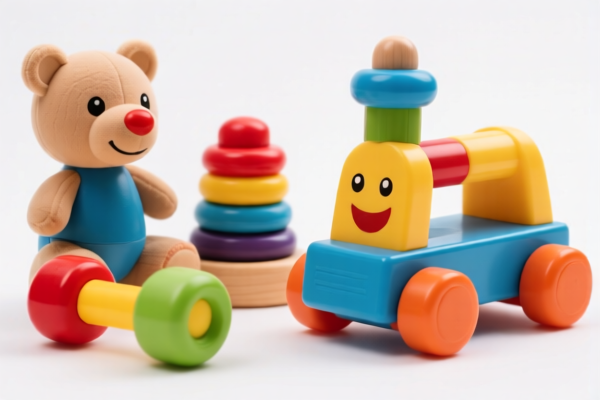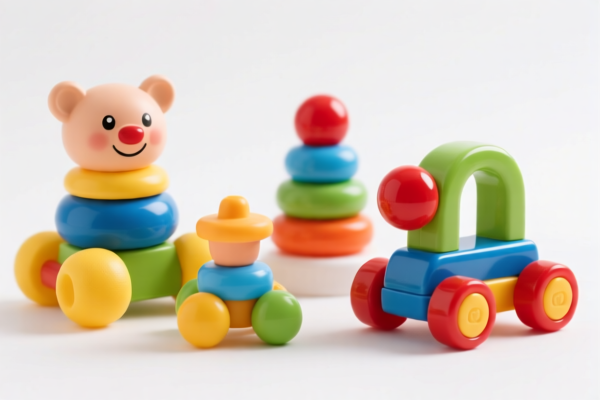| HS Code | Official Doc | Tariff Rate | Origin | Destination | Effective Date |
|---|---|---|---|---|---|
| 9503000090 | Doc | 30.0% | CN | US | 2025-05-12 |
| 9503000071 | Doc | 30.0% | CN | US | 2025-05-12 |
| 9505101000 | Doc | 37.5% | CN | US | 2025-05-12 |
| 9505104010 | Doc | 30.0% | CN | US | 2025-05-12 |
| 3926400010 | Doc | 35.3% | CN | US | 2025-05-12 |
| 3924104000 | Doc | 33.4% | CN | US | 2025-05-12 |
| 3924905650 | Doc | 40.9% | CN | US | 2025-05-12 |




Decorative Toys
Decorative toys are items primarily intended for visual appeal and aesthetic enhancement rather than active play. They serve to adorn spaces, express personal style, or commemorate events. While some may possess limited play value, their principal function lies in their ornamental qualities.
Material
A wide variety of materials are used in the production of decorative toys, including:
- Plastic: Common for mass-produced items due to its affordability and moldability. Types include PVC, ABS, and polystyrene.
- Ceramics: Often used for figurines, porcelain dolls, and detailed sculptures, offering a classic and delicate aesthetic.
- Wood: Provides a natural and rustic look, commonly found in carved figures, painted ornaments, and building block sets intended as displays.
- Metal: Used for sculptures, miniature replicas, and vintage-style toys, offering durability and a distinct appearance. Common metals include iron, brass, and tin.
- Glass: Employed for delicate ornaments, paperweights, and art glass figurines.
- Fabric & Plush: Used for stuffed animals displayed as collectibles or room décor, often featuring intricate designs.
- Resin: Allows for detailed sculpting and a variety of finishes, commonly used for figurines and modern art pieces.
- Paper & Cardboard: Used for origami, paper mache figures, and decorative cutouts.
Purpose
- Aesthetic Enhancement: To improve the visual appeal of a room, shelf, or collection.
- Personal Expression: Reflecting individual tastes, hobbies, or interests.
- Commemoration: Marking special occasions, holidays, or achievements.
- Collection: As items to be gathered and displayed based on themes or rarity.
- Gifting: Presented as decorative items rather than functional playthings.
Function
- Visual Focal Point: Drawing the eye and creating a sense of interest.
- Thematic Display: Contributing to a specific décor style or atmosphere.
- Symbolic Representation: Representing ideas, emotions, or cultural significance.
- Space Filling: Adding visual weight to shelves or tables.
- Conversation Starter: Unique or interesting items can spark dialogue.
Usage Scenarios
- Home Décor: Shelves, mantels, tables, windowsills, and nurseries.
- Collectors' Displays: Dedicated display cases or shelving units.
- Event Decoration: Parties, weddings, and seasonal celebrations.
- Gift Presentation: As decorative accents accompanying other gifts.
- Retail Displays: Showcasing products in an appealing manner.
- Seasonal Displays: Holiday-themed arrangements.
Common Types
- Figurines: Small sculpted representations of people, animals, or fictional characters.
- Ornaments: Decorative items hung on Christmas trees or displayed seasonally.
- Miniature Collections: Small-scale replicas of objects, buildings, or scenes. (e.g., dollhouse furniture, miniature villages)
- Stuffed Animals (Collectible): Plush toys displayed for aesthetic value rather than active play. (e.g., Beanie Babies, limited-edition plush)
- Art Dolls: Handcrafted dolls with unique designs and artistic features.
- Paperweights: Decorative glass or crystal objects used to hold papers in place.
- Wind Chimes: Decorative hanging ornaments that produce sound in the breeze.
- Sculptures: Three-dimensional art pieces often displayed on pedestals or shelves.
- Snow Globes: Decorative glass spheres containing a miniature scene and artificial snow.
- Terrariums: Decorative glass containers housing plants and miniature landscapes.
- Holiday-Themed Decorations: Items specific to holidays like Christmas, Easter, or Halloween.
Decorative toys can encompass a variety of items, and the appropriate HS code depends on the specific material and nature of the toy. Here's a breakdown of potentially relevant HS codes based on the provided information:
- 9503000090: This code covers tricycles, scooters, pedal cars and similar wheeled toys; dolls’ carriages; dolls, other toys; reduced-scale (“scaleˮ) models and similar recreational models, working or not; puzzles of all kinds; parts and accessories thereof. This is a broad category and could apply if the decorative toy is a miniature model or a doll. The total tax rate is 30.0%, with a base tariff of 0.0%, an additional tariff of 0.0%, and an additional tariff of 30% after April 2, 2025.
- 9503000071: This code specifically addresses “Children’s productsˮ as defined in 15 U.S.C. § 2052, labeled or determined by the importer as intended for use by persons under 3 years of age. If the decorative toy is clearly marketed for young children, this code may be applicable. The total tax rate is 30.0%, with a base tariff of 0.0%, an additional tariff of 0.0%, and an additional tariff of 30% after April 2, 2025.
- 3926400010: This code covers other articles of plastics and articles of other materials of headings 3901 to 3914: Statuettes and other ornamental articles, Bows and similar products for decorative purposes including gift-packaging and the like. If the decorative toy is made of plastic and is primarily ornamental, this code is relevant. The total tax rate is 35.3%, with a base tariff of 5.3%, an additional tariff of 0.0%, and an additional tariff of 30% after April 2, 2025.
Important Considerations:
- If the decorative toy is made of glass, HS code 9505101000 may be applicable, covering Christmas ornaments of glass.
- If the decorative toy is an artificial Christmas tree made of plastics, HS code 9505104010 may be applicable.
It is crucial to accurately determine the material composition and intended use of the decorative toy to select the correct HS code.
Customer Reviews
No reviews yet.